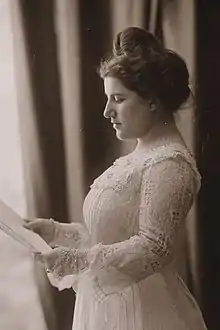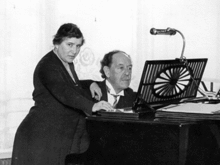Ida Ekman
Ida Paulina Ekman (22 April 1875 – 14 April 1942) was a Finnish soprano singer. She was also referred to as Ida Morduch-Ekman.[1] Her career was mainly in oratorio and lieder, and she was a renowned interpreter of the songs of Jean Sibelius, many of which were dedicated to her and her husband Karl Ekman,[2] with whose career her own was closely connected.[3] Sibelius regarded her as his favourite singer.[4]


Biography
Ida Paulina Morduch[5] was born in Helsinki in 1875 to Jewish parents Israel Jacob Morduch (1833–76) and Eva Grünblatt (1833–1913). Her stepfather was Arye Leib Krapinsky (1832–1897).[1] She studied at the Russian Girls School in Helsinki,[1] Vienna (under Pauline Lucca), Germany and Italy. She sang with the Nuremberg Opera for a time,[6] but her greatest success came in lieder. In 1895, when she was 19, she married the pianist, composer and conductor Karl Ekman, a piano student of Ferruccio Busoni. She appeared in concert with Edvard Grieg. Ernst Mielck's song "Heimath" (1898) was dedicated to Ida Morduch-Ekman.[7] She accompanied Robert Kajanus and Jean Sibelius on their European tour in the summer of 1900.[8] She was the a soloist with the Helsinki Philharmonic Orchestra on its visit to the 1900 World's Fair in Paris.[5] She probably sang in the concert of 25 July 1900 in the Salle de la Grande Harmonie in Brussels.[8] She had earlier been instrumental in bringing Sibelius's music to the attention of Johannes Brahms, who died in 1897.[9]
She was particularly appreciated by Sibelius himself, who dedicated a number of his songs to her and she was their first interpreter. There exists a manuscript score of the song "Spring is flying", Op. 13, No. 4, with an inscription from Sibelius "To Ida Ekman, the incomparable "Sibelius singer", with gratitude from Jean Sibelius".[10] She gave the first performance of "The Tryst", Op. 37, No. 5 in late January 1901 in Berlin.[11] Her Sibelius dedications included three songs from Op. 36 – "Black Roses", "But my bird is long in homing" and "Tennis at Trianon"; "On a balcony by the sea", Op. 38, No. 2,[9] and all the songs from Opp. 86, 88 and 90.[12][13] Ekman performed the Op. 90 songs for the first time at her jubilee concerts in October 1917, at the end of her career.[12]
After the retirement of Aino Ackté, Ida Ekman became the preeminent interpreter of Sibelius's songs. Sibelius wrote in his diary in 1918: "They - our female singers - 'they make too much' of every phrase. The absolute music which I write is so exclusively musical and strictly independent of words that reciting them is not a good idea. Ida Ekman has understood this which is why she is incomparable".[2]
Ida Ekman made some recordings between 1904 and 1908, including songs in 1906 that were among the first compositions by Sibelius ever to be recorded.[14] The Sibelius songs were "Was it a dream?", Op. 37, No. 4; "Longing", Op. 50, No. 2; "But my bird is long in homing", Op. 36, No. 2; "A maiden yonder sings", Op. 50, No. 3; "Black Roses", Op. 36, No. 1; "And I questioned then no further", Op. 17, No. 1; and "Tennis at Trianon", Op. 36, No. 3. [15] She also recorded songs by Richard Strauss and arias from operas by Tchaikovsky and Handel.[16] A selection of her recordings can be heard here.
She influenced Sibelius to orchestrate some of his songs originally written for voice and piano; these included "Spring is flying" (Op. 13, No. 4), "And I questioned then no further" (Op. 17, No. 1), "The Diamond on the March snow" (Op. 36, No. 6), "Sunrise" (Op. 37, No. 3), "On a balcony by the sea" (Op. 38, No. 2) and "Night" (Op. 38, No. 3), orchestrated between 1903 and 1914.[17]
On 8 January 1906, she sang Hector Berlioz's Les nuits d'été at the Berlin Singakadamie under Ferruccio Busoni.[18]
Ida and Karl Ekman had a son, Karl Ekman Jr (1895–1962),[1] a noted biographer of Sibelius. She died in 1942, aged 66.
In 2003, the manuscripts of four Sibelius songs ("The Girl Came from A Meeting With Her Love", "Was It A Dream?", "Spring Passes So Quickly", and "Lost") dedicated to Ida Ekman turned up in a Helsinki bank vault.[19][20]
References
- "Meliza's Genealogy". Archived from the original on 2011-07-07. Retrieved 2009-10-31.
- "The singers". www.sibelius.fi.
- Daniel M Grimley, The Cambridge Companion to Sibelius
- "BIS". Archived from the original on 2011-06-06. Retrieved 2009-10-31.
- Hillila, Ruth-Esther; Hong, Barbara Blanchard (September 4, 1997). "Historical Dictionary of the Music and Musicians of Finland". Greenwood Publishing Group – via Google Books.
- "carlonordling.se". www.carlonordling.se.
- "Heimath (Mielck, Ernst) - IMSLP: Free Sheet Music PDF Download". imslp.org.
- "Musical Finland in Brussels". Archived from the original on 2011-07-25. Retrieved 2009-10-31.
- "Kutri's Kormer". Archived from the original on 2009-04-06. Retrieved 2009-10-31.
- www.breitkopf.com
- Barnett, Andrew (September 4, 2007). "Sibelius". Yale University Press – via Google Books.
- "The last solo song collections". www.sibelius.fi.
- Barnett, Andrew (September 4, 2007). "Sibelius". Yale University Press – via Google Books.
- Det Virtuelle Musikbibliotek
- "The very first Sibelius recordings 1901-1908". www.fiftyrecords.com.
- "Ida Ekman Recordings 1904-1908".
- Det Virtuelle Musikbibliotek
- "Programs of Busoni's Orchestral Concerts". Archived from the original on 2008-09-05. Retrieved 2009-10-31.
- "News in brief". The Telegraph.
- "Sibelius Scores Found". www.boosey.com.
Sources
- Grove's Dictionary of Music and Musicians, 5th ed, 1954, Eric Blom, ed.